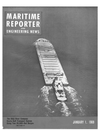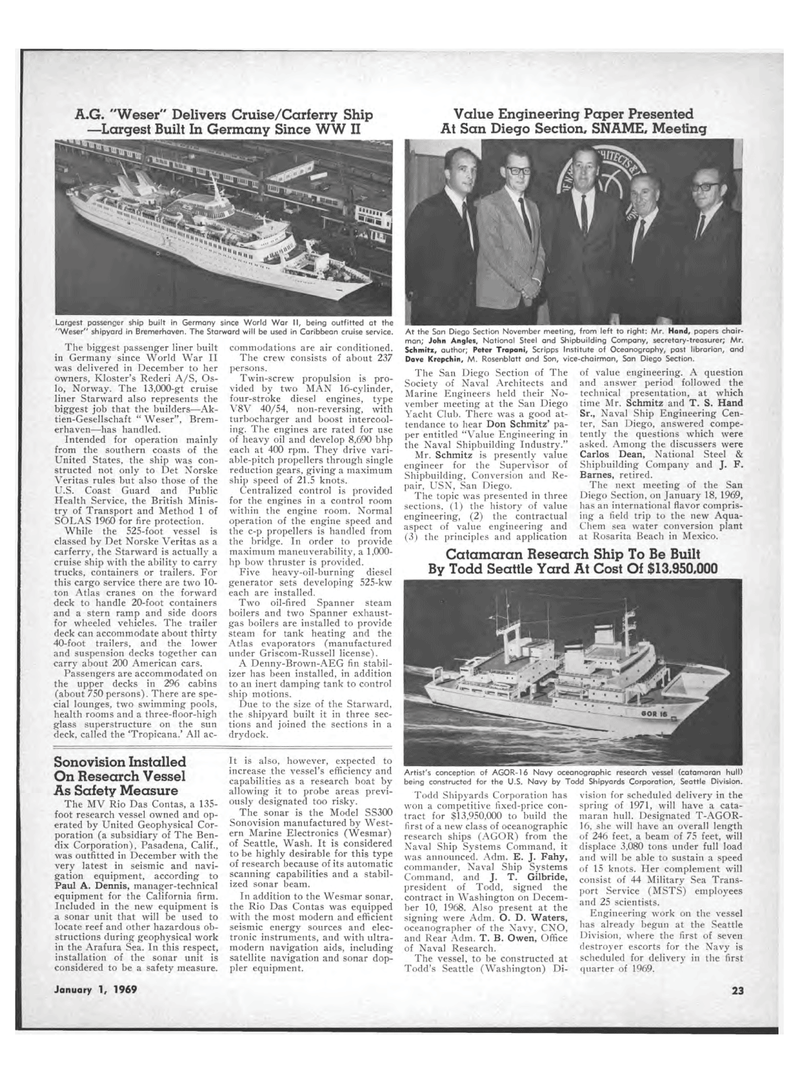
Page 25: of Maritime Reporter Magazine (January 1969)
Read this page in Pdf, Flash or Html5 edition of January 1969 Maritime Reporter Magazine
A.G. "Weser" Delivers Cruise/Cctrferry Ship ?Largest Built In Germany Since WW II Largest passenger ship built in Germany since World War II, being outfitted at the "Weser" shipyard in Bremerhaven. The Starward will be used in Caribbean cruise service. Value Engineering Paper Presented At San Diego Section, SNAME, Meeting At the San Diego Section November meeting, from left to right: Mr. Hand, papers chair-man; John Angles. National Steel and Shipbuilding Company, secretary-treasurer; Mr. Schmitz, author; Peter Trapani, Scripps Institute of Oceanography, past librarian, and Dave Krepchin, M. Rosenblatt and Son, vice-chairman, San Diego Section. The biggest passenger liner built in Germany since World War II was delivered in December to her owners, Kloster's Rederi A/S, Os-lo, Norway. The 13,000-gt cruise liner Starward also represents the biggest job that the builders?Ak-tien-Gesellschaft " Weser", Brem-erhaven?has handled. Intended for operation mainly from the southern coasts of the United States, the ship was con-structed not only to Det Norske Veritas rules but also those of the U.S. Coast Guard and Public Health Service, the British Minis-try of Transport and Method 1 of SOLAS 1960 for fire protection. While the 525-foot vessel is classed by Det Norske Veritas as a carferry, the Starward is actually a cruise ship with the ability to carry trucks, containers or trailers. For this cargo service there are two 10-ton Atlas cranes on the forward deck to handle 20-foot containers and a stern ramp and side doors for wheeled vehicles. The trailer deck can accommodate about thirty 40-foot trailers, and the lower and suspension decks together can carry about 200 American cars. Passengers are accommodated on the upper decks in 296 cabins (about 750 persons). There are spe-cial lounges, two swimming pools, health rooms and a three-floor-high glass superstructure on the sun deck, called the 'Tropicana.' All ac-Sonovision Installed On Research Vessel As Safety Measure The MV Rio Das Contas, a 135-foot research vessel owned and op-erated by United Geophysical Cor-poration (a subsidiary of The Ben-dix Corporation), Pasadena, Calif., was outfitted in December with the very latest in seismic and navi-gation equipment, according to Paul A. Dennis, manager-technical equipment for the California firm. Included in the new equipment is a sonar unit that will be used to locate reef and other hazardous ob-structions during geophysical work in the Arafura Sea. In this respect, installation of the sonar unit is considered to be a safety measure. commodations are air conditioned. The crew consists of about 237 persons. Twin-screw propulsion is pro-vided by two MAN 16-cylinder, four-stroke diesel engines, type V8V 40/54, non-reversing, with turbocharger and boost intercool-ing. The engines are rated for use of heavy oil and develop 8,690 bhp each at 400 rpm. They drive vari-able-pitch propellers through single reduction gears, giving a maximum ship speed of 21.5 knots. Centralized control is provided for the engines in a control room within the engine room. Normal operation of the engine speed and the c-p propellers is handled from the bridge. In order to provide maximum maneuverability, a 1,000-hp bow thruster is provided. Five heavy-oil-burning diesel generator sets developing 525-kw each are installed. Two oil-fired Spanner steam boilers and two Spanner exhaust-gas boilers are installed to provide steam for tank heating and the Atlas evaporators (manufactured under Griscom-Russell license). A Denny-Brown-AEG fin stabil-izer has been installed, in addition to an inert damping tank to control ship motions. Due to the size of the Starward, the shipyard built it in three sec-tions and joined the sections in a drydock. It is also, however, expected to increase the vessel's efficiency and capabilities as a research boat by allowing it to probe areas previ-ously designated too risky. The sonar is the Model SS300 Sonovision manufactured by West-ern Marine Electronics (Wesmar) of Seattle, Wash. It is considered to be highly desirable for this type of research because of its automatic scanning capabilities and a stabil-ized sonar beam. In addition to the Wesmar sonar, the Rio Das Contas was equipped with the most modern and efficient seismic energy sources and elec-tronic instruments, and with ultra-modern navigation aids, including satellite navigation and sonar dop-pler equipment. The San Diego Section of The Society of Naval Architects and Marine Engineers held their No-vember meeting at the San Diego Yacht Club. There was a good at-tendance to hear Don Schmitz' pa-per entitled "Value Engineering in the Naval Shipbuilding Industry." Mr. Schmitz is presently value engineer for the Supervisor of Shipbuilding, Conversion and Re-pair, USN, San Diego. The topic was presented in three sections, (1) the history of value engineering, (2) the contractual aspect of value engineering and (3) the principles and application Todd Shipyards Corporation has won a competitive fixed-price con-tract for $13,950,000 to build the first of a new class of oceanographic research ships (AGOR) from the Naval Ship Systems Command, it was announced. Adm. E. J. Fahy, commander, Naval Ship Systems Command, and J. T. Gilbride, president of Todd, signed the contract in Washington on Decem-ber 10, 1968. Also present at the signing were Adm. O. D. Waters, oceanographer of the Navy, CNO, and Rear Adm. T. B. Owen, Office of Naval Research. The vessel, to be constructed at Todd's Seattle (Washington) Di-of value engineering. A question and answer period followed the technical presentation, at which time Mr. Schmitz and T. S. Hand Sr., Naval Ship Engineering Cen-ter, San Diego, answered compe-tently the questions which were asked. Among the discussers were Carlos Dean, National Steel & Shipbuilding Company and J. F. Barnes, retired. The next meeting of the San Diego Section, on January 18, 1969, has an international flavor compris-ing a field trip to the new Aqua-Chem sea water conversion plant at Rosarita Beach in Mexico. vision for scheduled delivery in the spring of 1971, will have a cata-maran hull. Designated T-AGOR-16, she will have an overall length of 246 feet, a beam of 75 feet, will displace 3,080 tons under full load and will be able to sustain a speed of 15 knots. Her complement will consist of 44 Military Sea Trans-port Service (MSTS) employees and 25 scientists. Engineering work on the vessel has already begun at the Seattle Division, where the first of seven destroyer escorts for the Navy is scheduled for delivery in the first quarter of 1969. Catamaran Research Ship To Be Built By Todd Seattle Yard At Cost Of $13,950,000 Artist's conception of AGOR-16 Navy oceanographic research vessel (catamaran hull) being constructed for the U.S. Navy by Todd Shipyards Corporation, Seattle Division. January 1, 1969 23

 24
24

 26
26
